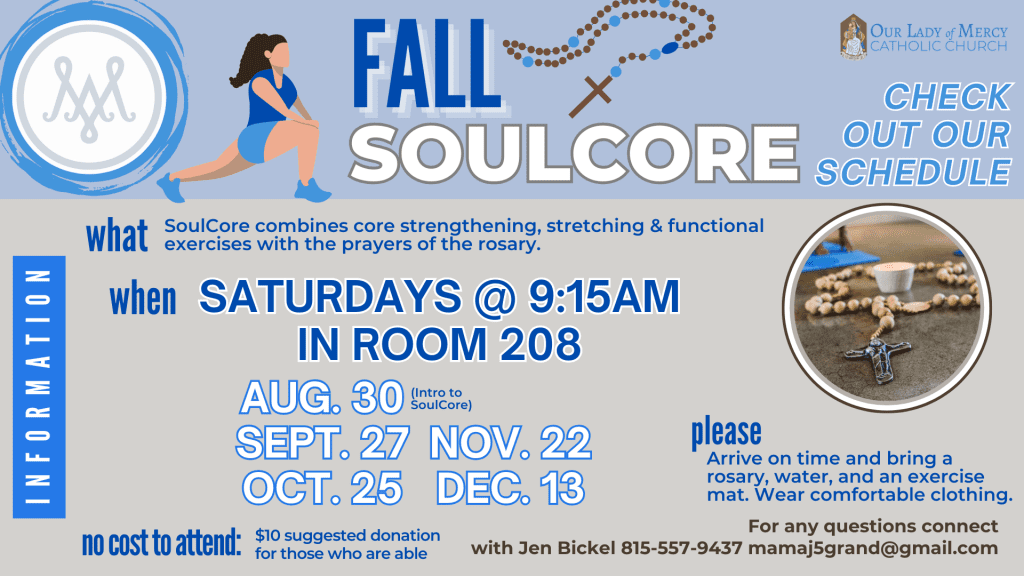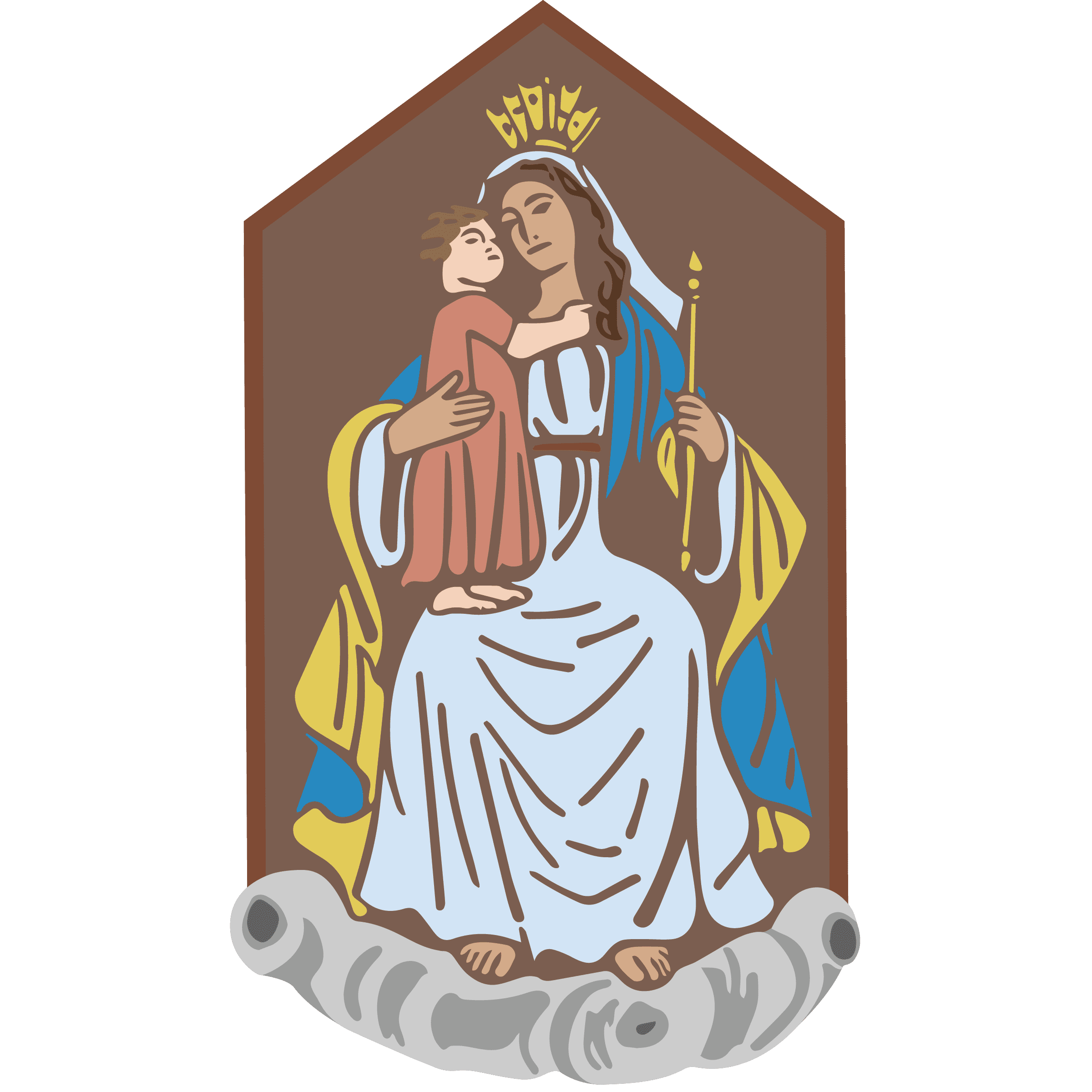SoulCore
SoulCore Ministry fosters Christ-centered discipleship through exercise to nourish women’s MIND, BODY, and SOUL.

Learn More About SoulCore
Workout with SoulCore
WHEN
Saturday mornings & Wednesday Evenings (check our latest schedule)
WHERE
Our Lady of Mercy Parish Life Center (PLC) please check the screen that lists our daily schedule.
WHO
Women, aged 18 and above.
PLEASE
Arrive 15 minutes prior to check in.
Bring an exercise mat and water.
Wear Comfortable clothing.
GOT QUESTIONS?
Please reach out and connect our SoulCore Instructor
Jen at mamaj5grand@gmail.com
Workout Details
Stretch and strengthening mat workout while we pray the rosary. Concludes with 10 minutes of meditative silent prayer followed by group prayer intentions.
Jen Bickel, a certified SoulCore instructor, will lead a SoulCore workout. What is SoulCore, you may wonder? Check out the video and the FAQs below to find out.
Soulcore – An invitation to discover the beauty & transforming power of the rosary in body & soul!
Meet Our SoulCore Leader

Jennifer is a former dance fitness instructor for nearly 30 years and lived an active lifestyle while raising her four daughters. After she retired from the fitness industry, Jennifer has been enjoying her five grandchildren but also seeking to have a deeper relationship with Jesus and Mary. Jennifer became consecrated to Mother Mary and the past 3 years of devotion to rosary has deepened her faith in many ways. Jennifer is a devout practicing Catholic and has embraced her community and fellowship at her parish along with her devout Catholic husband, Michael. “I believe the Lord has been calling me back to my passion of exercise. I am eager and excited to be on this new healthy journey with the SoulCore ministry, to faithfully lead, pray and most important to grow virtuous and expanding this awareness with others”.
A FEW OF JENNIFER’S FAVORITE SCRIPTURE VERSES
Matthew 22:36-40; Exodus 14:14
Frequently Asked Questions
What is SoulCore?
SoulCore is a movement that strengthens body & soul by combining the prayers of the rosary with core-strengthening, stretching and functional movement. SoulCore is a sensory experience that combines candlelight, aromatherapy, music and sacred art, providing participants the opportunity to nourish body, mind & soul while contemplating the mysteries and fruits of the rosary.
How is SoulCore different from other fitness disciplines?
SoulCore is a movement all its own. It is an exercise of spiritual and physical fitness through prayer. The pure intention of SoulCore is to bring Christians of all ages closer to Christ through the prayers of the Rosary.
SoulCore is founded in monotheism, one true God. It is based in Christian meditation, which is always focused on the life of Jesus Christ. SoulCore is about filling the mind & soul with the life and word of Christ, by meditating on the Mysteries and specifically, the virtues of each Mystery, to slowly be transformed more fully into the image and likeness of the heart and mind of Jesus and Our Blessed Mother.
Our deepest desire is to maintain the integrity of the Rosary and the Catholic faith, to encourage a deeper devotion to the Blessed Mother through the rosary, to grow in virtue and interior peace, and to be strengthened – in body and soul – to be fit instruments to do God’s will.
Our Lady’s desire is always to lead us closer to her son Jesus. As a Marian apostolate, SoulCore imitates her in striving to draw others closer to Christ through deeper reflection on his life and virtues in the rosary. Anything that could potentially lead us away from Christ is counter to our mission.
How long is each SoulCore Rosary?
A typical SoulCore Rosary is approximately 50-55 minutes in length.
Are participants saying the prayers out loud?
The SoulCore leader recites the first part of each prayer out loud, and the second part of every prayer is said in silence. This allows the participants to be reflective in the prayers and go deep in their meditation on the life and word of Christ.
What if I don’t know the Rosary?
SoulCore is a wonderful way to learn it! Each mystery and virtue is announced out loud. The first part of every prayer is also said out loud so participants are guided through it. For the second half of each prayer, until one knows the prayers by heart, one can reflectively ponder the virtue of the mystery. There are numerous resources online, in bookstores, and in Catholic churches that provide the prayers of the rosary.
What does the actual movement entail?
The movement involves a combination of core-strengthening, stretching and functional movement. We begin with some basic stretches to warm up the body and recite the Apostle’s Creed. Each Mystery begins with a scripture verse and a reflection, offering a time of rest. Participants are invited to do push-ups through each of the Our Father prayers. Movements will vary for each Hail Mary. A position of surrender is offered during the Glory Be. The movements are truly just an invitation. The main focus of SoulCore is the prayers of the rosary. We recommend modifying and resting as needed, always honoring your body.
What is the fitness level required for this workout?
Since spiritual fitness through prayer is the main focus of SoulCore, there is no specific fitness level. The physical movements can be challenging depending on who is leading the class or DVD/Digital Download, however all of the movements are simply invitations. The prayers are the focus – staying centered on the mysteries and virtues – and the movements are simply intended to enhance the prayer experience, by deepening our connection of body and soul. We strongly encourage modifying or resting according to your abilities on any given day.
If I become a Leader, can SoulCore classes be customized according to the abilities of the Leader and participants?
Absolutely! Since the movements are secondary to the prayers, SoulCore Leaders can offer classes at any fitness level. Some Leaders offer SoulCore with the majority of the movements being gentle stretches, others offer SoulCore with the movements done completely from a chair. As long as the movements are in line with the integrity of SoulCore, Leaders are welcome to customize accordingly. We find that any of these movements, when done in conjunction with the prayers, offers a deeper connection with Christ in body and soul.
Is SoulCore approved by the Church?
Thank you for thoughtful discernment regarding SoulCore’s approval by the Church. SoulCore is an ecumenical apostolate rooted in the richness and beauty of the Holy Rosary. At this time SoulCore does not yet have an imprimatur. It’s a challenge due to the fact that we do not have a written body of work. However, SoulCore is based in the Diocese of Lafayette Indiana and Bishop Timothy Doherty has been very supportive of our mission and even requested our diocesan paper, The Catholic Moment, write an article about SoulCore. It is also approved by many priests around the country. Additionally, SoulCore has been featured in various Catholic media outlets including, EWTN radio, Sirius XM The Catholic Channel, Ave Maria Radio, Relevant Radio, National Catholic Register, Ignatius Press and more. SoulCore is also offered in collaboration with various Catholic conferences such as FOCUS SLS and SEEK.
“Behold, I make all things new.”
Revelation 21:5
Testimonials
Key Fitness News
Is Yoga Okay for Catholics?
3/2/2020 by Lindsey Kettner heard on Relevant Radio
It’s a hot topic among Catholics today—can a practicing Catholic, in good conscience, practice yoga? Whenever the question arises, people tend to dig in their heels with their firmly rooted convictions. Depending on whom you ask, the answers can vary from “it’s harmless” to “it’s absolutely forbidden!”
Fr. Richard Simon recently addressed this controversial question on Father Simon SaysTM. If you’re confused by the mixed messages, like Luz was when she asked this question, see what Fr. Simon had to say.
“I will give you my point of view—I think the stretching is fine. However, there are people who say even the yoga positions are named for Hindu gods and you’re invoking them,” he explained.
In true Fr. Simon fashion, he broke down the meaning of the word behind the popular fitness trend. “The word yoga is related to the English word yoke or the Spanish word yugo. You know, you’ve got a yoke on an ox, and that’s important because you’re yoking yourself to some god.”
There’s nothing wrong with stretching and strengthening one’s body—in fact, physical fitness is great—but you might want to be leery of yoga classes. Many include meditation, prayer, and spiritual philosophies that are not compatible with Catholicism.
“If you can kind of do stretches that are yoga-esque, that’s fine, but you’ve got to be very careful when you go to a yoga class because there are some people who are really into the yoga thing,” warns Fr. Simon.
“If there is a definitive declaration that yoga is forbidden to Catholics, I would love to hear it, but I have never heard that,” he continued. “But on the other hand, it makes me nervous.”
Since the Church doesn’t have a decisive teaching on it, it’s up to you to use your best judgment. But as you do so, consider that many clergy warn against it. Bottom line from Fr. Simon: it’s not worth the risk.
He counseled Luz: “Stretching is great but when you go into some yoga class, you never know what you’re getting into. I would come down on the side of, I’ve got enough trouble; I don’t want to risk that.”
If you’re looking for a replacement for yoga in your fitness routine, there are several Catholic alternatives to try that replace Hindu poses and meditation with Christian prayer and exercise.
Listen to the full segment located on this the bottom of the following page link
Yoga and the Catholic Church
from the Diocese of Joliet Office of Catechetical Formation
In 1989, Pope Benedict XVI (then Cardinal Joseph Ratzinger) published a letter as Prefect for the Congregation for the Doctrine of the Faith, responding to what he called an “urgent need.” The 13- page document described the “spiritual restlessness” of the times marked by the “driving pace of a technologically advanced society.” Recognizing the desire in many to find greater peace and balance in their lives, he noted the growing interest among those seeking non-Christian methods of meditation, the most notable being the practice of yoga. But is there a place for yoga in the Christian tradition? Noting confusion on this issue in the Christian world and the need for pastoral guidance, Ratzinger sought to establish solid doctrinal criteria by which the question can be answered. Click here to read the rest of the article.

